Detecting huge craters in Egypt
Scientists have discovered an unprecedented large crater in the Sahara desert. The pit mouth is about 31km wide, twice the largest pit ever discovered in this area.

Kebira pit in western Egypt has a radius of about 31 km
The new crater can be formed from the impact of a meteorite about 1 km wide with the ground, destroying everything within hundreds of kilometers.
Boston University scientists Farouk El-Baz and Eman Ghoneim discovered this crater and named it Kebira.
Kebira means 'big' in Arabic and is almost similar to the name of the area Gilf Kebir (Egypt), where a giant hole is discovered.
El-Baz said, ' Kebira has an area of 125 football fields or an area of Cairo from the airport in the Northeast to the pyramids in the Southwest. When studying similar holes, we focused on small, measurable expressions on the ground. Photos from space give us a more panoramic view . '
Types of cosmic holes often have a circular belt. However, they can be eroded by water and wind, so they are rarely detected with the naked eye.
Ghoneim said, there are two ancient rivers that once flowed through the Kebira hole from the East and West.
T. Nam
- Found a giant meteorite 500 million years ago
- The explanation for the mysterious giant craters in Siberia
- It's hard to build a great Egyptian monument by hand, which secret technology did they use?
- Detecting huge hollow black holes in the universe
- Huge meteorite pit
- These mysterious giant craters in Siberia
- Detecting huge mud and sand flow under the seabed
- The third mysterious crater in Siberia
- Egypt's oldest pyramid airbag
- Video: Parrots learn to fly on active craters
- Discovered 280 new craters on the Moon
- Discovered traces of life in the crater 375 million years
 Van Allen's belt and evidence that the Apollo 11 mission to the Moon was myth
Van Allen's belt and evidence that the Apollo 11 mission to the Moon was myth The levels of civilization in the universe (Kardashev scale)
The levels of civilization in the universe (Kardashev scale) Today Mars, the sun and the Earth are aligned
Today Mars, the sun and the Earth are aligned The Amazon owner announced a secret plan to build a space base for thousands of people
The Amazon owner announced a secret plan to build a space base for thousands of people